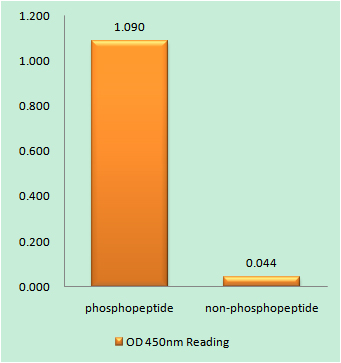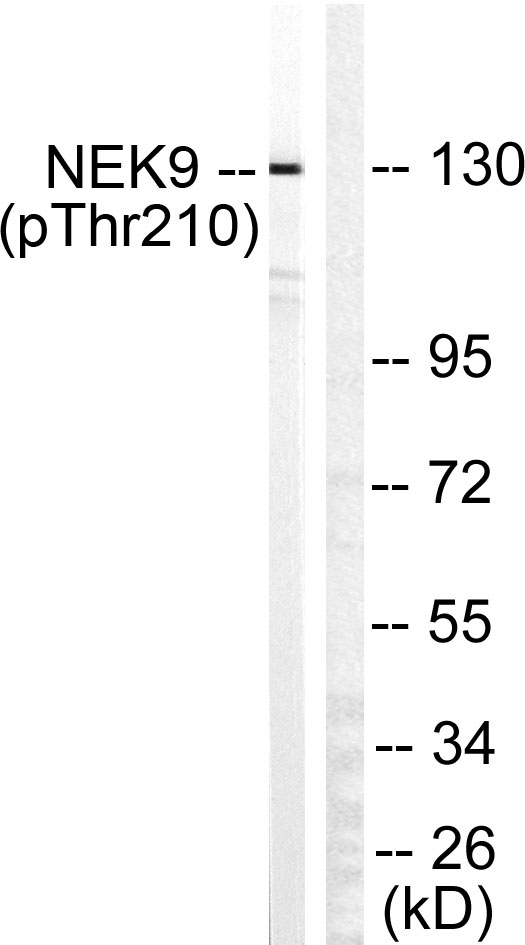Nek9 (phospho Thr210) Polyclonal Antibody
- Catalog No.:YP0564
- Applications:WB;IHC;IF;ELISA
- Reactivity:Human;Mouse;Rat
- Target:
- Nek9
- Gene Name:
- NEK9
- Protein Name:
- Serine/threonine-protein kinase Nek9
- Human Gene Id:
- 91754
- Human Swiss Prot No:
- Q8TD19
- Mouse Gene Id:
- 217718
- Mouse Swiss Prot No:
- Q8K1R7
- Immunogen:
- The antiserum was produced against synthesized peptide derived from human NEK9 around the phosphorylation site of Thr210. AA range:176-225
- Specificity:
- Phospho-Nek9 (T210) Polyclonal Antibody detects endogenous levels of Nek9 protein only when phosphorylated at T210.
- Formulation:
- Liquid in PBS containing 50% glycerol, 0.5% BSA and 0.02% sodium azide.
- Source:
- Polyclonal, Rabbit,IgG
- Dilution:
- WB 1:500 - 1:2000. IHC 1:100 - 1:300. IF 1:200 - 1:1000. ELISA: 1:20000. Not yet tested in other applications.
- Purification:
- The antibody was affinity-purified from rabbit antiserum by affinity-chromatography using epitope-specific immunogen.
- Concentration:
- 1 mg/ml
- Storage Stability:
- -15°C to -25°C/1 year(Do not lower than -25°C)
- Other Name:
- NEK9;KIAA1995;NEK8;NERCC;Serine/threonine-protein kinase Nek9;Nercc1 kinase;Never in mitosis A-related kinase 9;NimA-related protein kinase 9;NimA-related kinase 8;Nek8
- Observed Band(KD):
- 110kD
- Background:
- This gene encodes a member of the NimA (never in mitosis A) family of serine/threonine protein kinases. The encoded protein is activated in mitosis and, in turn, activates other family members during mitosis. This protein also mediates cellular processes that are essential for interphase progression. [provided by RefSeq, Jul 2016],
- Function:
- catalytic activity:ATP + a protein = ADP + a phosphoprotein.,cofactor:Magnesium.,developmental stage:Expression varied mildly across the cell cycle, with highest expression observed in G1 and stationary-phase cells.,domain:Dimerizes through its coiled-coil domain.,enzyme regulation:Activated during mitosis by intramolecular autophosphorylation. Activity and autophosphorylation is activated by manganese >> magnesium ions. Sensitive to increasing concentration of detergents. It is not cell-cycle regulated but activity is higher in G0-arrested cells.,function:Pleiotropic regulator of mitotic progression, participating in the control of spindle dynamics and chromosome separation. Phosphorylates different histones, myelin basic protein, beta-casein, and BICD2. Phosphorylates histone H3 on serine and threonine residues and beta-casein on serine residues. Important for G1/S transition and S pha
- Subcellular Location:
- Cytoplasm . Nucleus .
- Expression:
- Most abundant in heart, liver, kidney and testis. Also expressed in smooth muscle cells and fibroblasts.
- June 19-2018
- WESTERN IMMUNOBLOTTING PROTOCOL
- June 19-2018
- IMMUNOHISTOCHEMISTRY-PARAFFIN PROTOCOL
- June 19-2018
- IMMUNOFLUORESCENCE PROTOCOL
- September 08-2020
- FLOW-CYTOMEYRT-PROTOCOL
- May 20-2022
- Cell-Based ELISA│解您多样本WB检测之困扰
- July 13-2018
- CELL-BASED-ELISA-PROTOCOL-FOR-ACETYL-PROTEIN
- July 13-2018
- CELL-BASED-ELISA-PROTOCOL-FOR-PHOSPHO-PROTEIN
- July 13-2018
- Antibody-FAQs
- Products Images

- Immunohistochemical analysis of paraffin-embedded Human brain. Antibody was diluted at 1:100(4° overnight). High-pressure and temperature Tris-EDTA,pH8.0 was used for antigen retrieval. Negetive contrl (right) obtaned from antibody was pre-absorbed by immunogen peptide.

- Enzyme-Linked Immunosorbent Assay (Phospho-ELISA) for Immunogen Phosphopeptide (Phospho-left) and Non-Phosphopeptide (Phospho-right), using NEK9 (Phospho-Thr210) Antibody

- Immunofluorescence analysis of HeLa cells, using NEK9 (Phospho-Thr210) Antibody. The picture on the right is blocked with the phospho peptide.

- Western blot analysis of lysates from HepG2 cells, using NEK9 (Phospho-Thr210) Antibody. The lane on the right is blocked with the phospho peptide.



